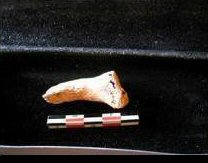So it also goes with places like Bulgaria. I found a really wonderful Byzantine cross on a trip there, from the 18th century (unless you are doing it one time, to experience the paperwork and process of buying and bringing in an antique, I discourage you from doing so) and the place is littered with ancient monasteries and churches.
On the Black Sea island called Sveti Ivan, which is Bulgarian for St. John (the Baptist), researchers from the Oxford Radiocarbon Accelerator Unit at Oxford University have dated a knuckle bone found by archaeologist Kazimir Popkonstantinov buried beneath a church. It originates from the first century AD, the time of John The Baptist’s life, and the DNA was consistent with a person of Near East heritage.
They did a mitochondrial DNA genome sequence from three of the human bones to establish they were all from the same individual, and they identified a mtDNA haplotype as being a group most commonly found in the Near East, the Middle East today. They established that the bones were probably of a male individual after an analysis of the nuclear DNA from samples.

Credit: Oxford
Obviously this is just a 'cool' speculation if you like history, there can never be a way to determine if the bone belonged at anyone important at all, much less a prominent religious figure. It's the kind of stuff National Geographic lives for, and they have a show on it airing tonight. Bulgarian archeologists found the small box made next to the sarcophagus and it was made from volcanic ash and bore an ancient Greek inscription referencing John and his feast day as well as a personal prayer asking God to “help your servant Thomas.” They speculate Thomas may have been the person assigned to transport the relic to the island and that it came came from Cappadocia which, like I said above, is stuffed full of good history, and nice hiking if that is your thing. They further believe the bones may have come from Antioch, where a relic of John’s right hand is supposed to have been kept until the tenth century.
Possible? Sure, anything is possible. Constantinople was the capital of the Roman Empire so they may have removed the bones from Jerusalem and they could have gone on from there. It's unlikely a random first century AD hobo was important enough to be buried there.
“We were surprised when the radiocarbon dating produced this very early age. We had suspected that the bones may have been more recent than this, perhaps from the third or fourth centuries. However, the result from the metacarpal hand bone is clearly consistent with someone who lived in the early first century AD,” said Oxford archaeologist Thomas Higham.




Comments